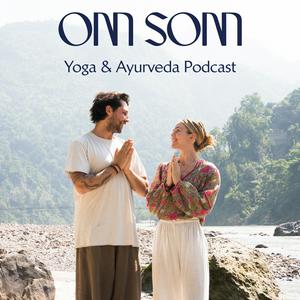Prāṇāyāma: The Gateway to Inner Stillness
PRACTICE WITH US:365 Sadhana Sanghahttps://practice.omsom.yoga/365-sadhana-sandha/join100 Hr Asana Sadhana Dharmahttps://practice.omsom.yoga/asana-sadhana-dharma-otoBali Retreathttps://omsom.yoga/bali-retreat-2025300 Hr India & Berwickhttps://omsom.yoga/300-hour-advanced-hatha-yoga-training-2025200 Hr Berwickhttps://omsom.yoga/200-hour-yoga-teacher-training-berwick-2025ON THIS WEEK’S EPISODE: PRĀṆĀYĀMA — MASTERING THE BREATHIn this episode, we explore the fourth limb of Aṣṭāṅga Yoga—Prāṇāyāma, often described as the gateway between the physical practices of āsana and the inner limbs of meditation. Aaron and Paige guide us through a rich, grounded, and traditional understanding of what it means to master the breath—not just as a technique, but as a means of refining our awareness and expanding our life force. We discuss the etymology of prāṇa (life-force) and āyāma (expansion, restraint); how prāṇāyāma links body, breath, and mind; why traditional teachings always follow āsana with prāṇāyama—not the other way around; and the difference between breath control and energy mastery.TEXTURAL SOURCESHaṭha Yoga Pradīpikā 2.1atha āsane dṛḍhe yogī vaśī hita-mitāśanaḥ |gurūpadiṣṭa-mārgeṇa prāṇāyāmān samabhyaset ||“Established in steadiness of āsana, with mastery, moderate diet, and guided by the teacher’s path—the yogī should begin the practice of prāṇāyāma.”Gheraṇḍa Saṃhitā 5.1 describes prāṇāyāma as one of the seven limbs of Haṭha Yoga, along with ṣaṭkarma, āsana, mudrā, pratyāhāra, dhyāna, and samādhi. The eight classical kumbhakas (retentions) are listed and broken down: Sūrya Bhedana, Ujjāyī, Śītalī, Bhastrikā, Bhrāmarī, Mūrchā, Plāvinī, and Kevalī.We explore how to begin prāṇāyāma safely: after establishing a stable āsana practice and with guidance from a teacher. The value of simple breath awareness (śvāsapraśvāsa) as a foundation. The role of retention (kumbhaka) in shifting mental states and preparing for pratyāhāra. Tips for integrating breathwork into daily life for clarity, steadiness, and energy regulation.Prāṇāyāma is not about force or control—it’s about intimacy with the breath, trust in your system, and a commitment to deepening presence. It is a bridge, a purifier, and a catalyst for inner stillness.SHARE & CONNECT:Thank you for listening to the Om Som Yoga & Ayurveda Podcast.Please share this episode with someone it might support, and connect with us on social media or via our website.Instagram: @OmSom.yogaWebsite: OmSom.yogaWe operate a yoga studio in Berwick, Victoria, Australia, offering classes, workshops, and Yoga Teacher Training programs. We'd love to connect with you wherever you are on your journey.OM

